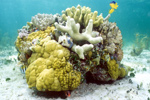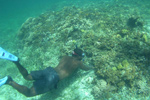

Nassau Grouper (Epinephelus striatus)
photo: K. Holmes
The Nassau grouper, Epinephelus striatus, a member of the sea bass family (Serranidae), was historically found throughout the tropical western Atlantic Ocean, including the Caribbean Sea, the Gulf of Mexico, the southeastern U.S., Bermuda, and northern South America (Sadovy and Eklund 1999). Currently, this species occupies only a fraction of its previous range, and is classified as Endangered according to the World Conservation Union (IUCN 2006). Under this definition, endangered taxa are those that have suffered a high rate of population decline and are at risk of extinction; E. striatus has declined by about 60% over the last three decades (IUCN 2006). Historically, the grouper fishery has been one of the most important and valuable throughout its range (Sadovy and Eklund 1999, Gascoigne 2002). Grouper is used in traditional dishes, such as boiled fish and grouper fingers, where it is valued for having relatively few bones and being easy to eat. In The Bahamas, where stocks are fished, Nassau grouper has been the most valuable finfish in recent years. Commercial landings there were valued at over BSD$ 2.7 million in 2003 (Department of Fisheries [now, Marine Resources], The Bahamas undated).
Nassau grouper grow slowly and have delayed reproduction, reaching sexual maturity from 4-8 years of age when they reach 40-50 cm in length (Ray and McCormick-Ray 2004). These characteristics hinder population recovery from low densities, enhancing vulnerability to overfishing. These groupers are long-lived, capable of surviving over 20 years in the wild, and have naturally low adult mortality (Sadovy and Eklund 1999). Reproductive rate and number of eggs per reproductive event increase with age in this species, with large fish producing 5-6 million eggs per season. Most groupers change sexes with age, although this may not be the case for E. striatus. Fishing often targets larger individuals, eliminating those with highest reproductive capacity and skewing the age class distribution to juveniles with lower survivorship (Gascoigne 2002). During the winter months (e.g., November to February in The Bahamas, and December to March in Belize), adults undergo breeding migrations to specific offshore areas, either locally or up to hundreds of kilometers away from their resident habitats, where they form ephemeral spawning aggregations during the week around the full moon (Starr et al. 2007). These groups, historically numbering in the tens of thousands, form for reproductive and courtship purposes (Sadovy and Eklund 1999). Because these aggregations are predictable and often known to local fishermen, large numbers of fish can be readily caught during spawning. Uncontrolled exploitation has completely extirpated or reduced many spawning aggregations to a few dozens to thousands of fish, rendering many stocks commercially extinct, and disrupting spawning behavior (Sala et al. 2001, Gascoigne 2002, Sadovy 2002, Ray and McCormick-Ray 2004, Sadovy and Domeier 2005). Once eliminated, spawning aggregations have not been observed to form again, suggesting that knowledge of spawning sites depends on cultural transmission (Bolden 1980). Young groupers, in the absence of enough older, reproductively experienced individuals, seem unable to locate their spawning site. As a consequence, small aggregations with too few experienced individuals to facilitate enough new recruits to the aggregation may be doomed to extinction (Sadovy and Eklund 1999, Starr et al. 2007).
Measures have been instituted to limit fisheries in response to the observed decline in grouper numbers. These include seasonal closures (e.g., during the winter spawning months) and spatial closures around known spawning sites. In place also are gear restrictions and harvest limits for fish size and number. Commonly employed fishing methods include handline, traps, and spear guns. Marine protected areas have been hailed as one of the most promising methods for protecting Nassau Grouper (Sadovy and Eklund 1999, Gascoigne 2002). Taxation based on vessel or harvesting characteristics is another possible alternative measure.
Habitat use, diet, and ecological role vary throughout the grouper life cycle (Sadovy and Eklund 1999, Perry Institute undated). Larvae hatch from pelagic eggs within a day after fertilization. After about 30-50 days, small juveniles leave the water column, shifting to inshore benthic nursery areas such as algal beds, seagrass, or reefs, where they will start life as relatively sedentary, demersal organisms. As they grow, they gradually shift their residences, to deeper reef habitats containing adequately sized holes, cracks, and other concavities (Ray and McCormick-Ray 2004). As adults, with the exception of the annual breeding migrations, Nassau grouper rarely disperse from their territories. They also shift their diets as they age, with juveniles feeding mainly on crustaceans, and adults feeding on a mix of invertebrates and fishes. Nassau grouper are among the larger reef fish, reaching up to 120 cm (3.9 feet) in length and approximately 25 kg (55 lbs.) in weight (Ray and McCormick-Ray 2004). A predator whose diet includes crustaceans, reef fishes, and octopuses, E. striatus plays a key role in reef communities (Mumby et al. 2006). Throughout its life cycle, this species also serves as prey for reef sharks, barracuda, dolphins, and humans. In addition, as with other reef fishes, E. striatus acts in a suite of symbiotic relationships, visiting cleaning stations, for example, where various species of small fishes (especially certain wrasses and gobies) or shrimps remove parasites from their exterior and inside their mouths. Thus, Nassau groupers are functionally linked to reef communities in numerous ways, and decreases in their populations will have community-wide impacts.
Bolden, S.K. 1980. Long-distance movement of a Nassau grouper (Epinephelus striatus) to a spawning aggregation in the central Bahamas. Fisheries Bulletin 98(3): 642-645.
Coleman, F.C., C.C. Koenig, A.M. Eklund, and C.B. Grimes. 1999. Management and conservation of temperate reef fishes in the grouper-snapper complex of the southeastern United States. In J.A. Musick (ed.) Life in the Slow Lane: Ecology and Conservation of Long-Lived Marine Animals. American Fisheries Society, Bethesda, Maryland, USA.
Coleman, F.C., C.C. Koenig, G.R. Huntsman, J.A. Musick, A.M. Eklund, J.C. McGovern, R.W. Chapman, G.R. Sedberry and C.B. Grimes. 2000. Long-lived reef fishes: the grouper-snapper complex. American Fisheries Society Policy Statement. Fisheries 25(3): 14-21.
Fisheries Department, The Bahamas. Undated. The Nassau Grouper Fishery of the Bahamas.
Gascoigne, J. 2002. Grouper and Conch in The Bahamas: Extinction or management? The choice is now. MacAlister Elliot & Partners, Limited; B.R.E.E.F. The Bahamas Reef Environment Educational Foundation. Available from www.macalister-elliott.com/reports/1651R03A.pdf
IUCN 2006. 2006 IUCN Red List of Threatened Species. www.iucnredlist.org. (Last accessed on 06 January 2007).
Mumby, P.J., C.P. Dahlgren, A.R. Harborne, F. Micheli, D.R. Brumbaugh, K.E. Holmes, J.M. Mendes, K. Broad, J.N. Sanchirico, K. Buch, S. Box, R.W. Stoffle, and A.B. Gill. 2006. Fishing, trophic cascades, and the process of grazing on coral reefs. Science 311: 98-101.
Perry Institute. Undated. Nassau Grouper Epinephelus striatus. CMRC Poster Series No. 3. Lee Stocking Island, Bahamas and Jupiter, Florida.
Ray, G.C. and J. McCormick-Ray. 2004. Coastal-Marine Conservation: Science and Policy. Blackwell Science, Malden, Massachusetts, USA.
Sadovy, Y. 2002. The Nassau Grouper: A Cautionary Tale of Discovery, Science and Management. Available in part from www.scrfa.org/server/spawning/doc/Grouper.pdf
Sadovy, Y. and M. Domeier. 2005. Are aggregation-fisheries sustainable? Reef fish fisheries as a case study. Coral Reefs 24:254-262.
Sadovy, Y. and Eklund, A.-M. 1999. Synopsis of Biological Data on the Nassau Grouper, Epinephelus striatus (Bloch, 1792), and the Jewfish, E. itajara (Lichtenstein, 1822). NOAA Technical Report, NMFS 146. Available from http://www.flmnh.ufl.edu/fish/Gallery/Descript/NassauGrouper/tr146.pdf
Sala, E., E. Ballesteros and R.M. Starr. 2001. Rapid decline of Nassau grouper spawning aggregations in Belize: Fishery management and conservation needs. Fisheries, 26:23-31.
Starr, R.M., E. , E. Ballesteros, and M. Zabala. 2007. Spatial dynamics of the Nassau grouper (Epinephelus striatus) in a Caribbean atoll. Marine Ecology Progress Series. In press.






